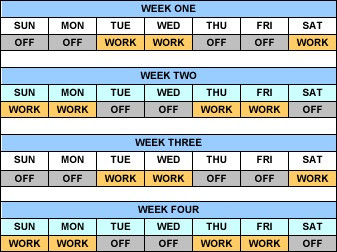

#4 3 3 4 WORK SCHEDULE PROFESSIONAL#
Prior to his coaching career, Vermes was a member of 1990 United States World Cup team and had a distinguished professional career both in the MLS and overseas. At the 2012 NSCAA Convention in Kansas City, I had the pleasure of watching Peter Vermes, Head Coach of Sporting Kansas City, run a session titled Approach Play with Finishing in a 4-3-3. In many cases, the total overtime is less. When it's inside the schedule, it is shared equally by the entire staff. When the overtime is outside the schedule, it requires volunteers or forced / mandated overtime. The difference is that the 5th week of the schedule would be devoted to relief coverage.ĭoing this would shift the OT from outside the schedule to inside the schedule. Similar to Option #1, you would have a 5-week schedule that averages 42 hours a week. Keep the OT in the schedule and use your extra capacity to build relief coverage into the schedule to cover absences. If you already have enough staff to create a 5-crew schedule, here's a way to save money. 5 crews * 36-hours/week * 1.4 benefit loading cost = 252 hours of pay/week.4 crews * 40 hours/week * 1.4 benefit loading cost + 4 crews * 4 hours of OT pay/week = 240 hours of pay/week.Let's do a quick cost comparison of 4-crew schedules vs. You'll either need a 5-crew schedule (see Option #1), a schedule with 11.5-hour shifts (see Option #4), or a crewless schedule that is custom-designed around your staff size. If you don't have enough part-time employees or you don't have employees from another department to cover the 8-hour gap in coverage every week, you'll won't be able to use Options #2 or #3. These can only be used by organizations such as police departments that are allowed to average the work hours over a 2-week period. If you are subject to Federal law that requires overtime after 40 hours a week, you won't be able to use Options #2 or #4. This won't completely eliminate the overtime, and you would have to be able to average the work hours over a 2-week period. You would have to adopt a 12-hour shift pattern in which the 48-hour weeks and 36-hour weeks were staggered. If you include a 30-minute unpaid meal break in the 12-hour shift, you only have to pay employees for 11.5 hours. That uncovered shift is not shown in the table below.Ĥ. In the sample shown below, there is an 8-hour gap in coverage on Wednesday that would have to be given to part-time employees or someone outside the four crews. This does not require the averaging of pay over a 2-week period or a pattern with staggered 36 and 48-hour weeks. If you devote one day a week to 4-hour shifts and give two 4-hour shifts (or one 8-hour shift) to employees who are outside the group, the remaining four crews would average 40 hours a week. That uncovered shift is not shown in the table below.ģ. In the sample shown below, the 8-hour afternoon shift on Wednesday would have to be given to employees who are not part of the four crews. You would have to use a 12-hour work pattern in which the 36-hour weeks and 48-hour weeks are staggered and you would have to be able to average the work hours over a 2-week period (most companies can't because of the overtime laws). If you devote one day a week to 8-hour shifts and give one of the three 8-hour shifts to employees who are outside the group (e.g., part-time employees), the remaining four crews would average 40 hours a week. Here's one example of a 5-crew schedule:Ģ. There will also be one shift with double coverage (in this case it's the Friday day shift). Just change all the 48-hour work weeks to 36 hours by eliminating one of the shifts. To maintain the same coverage, this will require 5 crews (a 25% increase in headcount), rotating shifts, and a 4-hour pay cut for all employees. In addition to higher costs, this will also require other sacrifices as seen in the following four approaches to eliminating overtime in 12-hour schedules for 24/7 coverage:ġ. In most cases, this is more expensive than simply keeping overtime in the schedule. Reducing the hours of work to 40 or less a week will result in gaps in the coverage and will require additional personnel to fill the gaps. When you divide the 168 hours in a week (7 days/week * 24 hours/day = 168 hours/week) by the 4 crews, you get a average of 42 hours/week. With 12-hour shifts, this will require half the work weeks to be 36 hours (three 12-hour shifts) and half to be 48 hours (four 12-hour shifts). Most 12-hour shift schedules for 24/7 coverage use 4 crews. I have repeatedly tried to argue the fallacy of this belief, yet I continue to get requests for 12-hour schedules with no overtime in them. They view overtime as evil or an unnecessary expense. In many organizations, especially public agencies, avoiding overtime is a high priority.


 0 kommentar(er)
0 kommentar(er)
